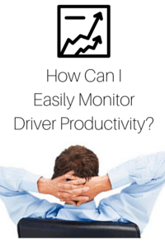Currently, I'm traveling the country, meeting with as many of you as I can.
While doing so, something is becoming very apparent. There is something at the core of running your business that is not being monitored. Something so basic and critical to your business' health, that you would think that it would be the one metric that is, for sure, being watched.
Shockingly, this is not the case. In fact, most folks do not have a clue.
There are many people that ask me how eTruckBiz For FXG can save them money. There are a multitude of ways, but one of the biggest, is how we monitor and track this one business metric, on your behalf, with no effort on your part.
That's right, we can track and monitor your driver productivity, without you having to do anything. Then, our cutting edge system sends you the analysis results, in the form of a weekly email.
Driver productivity is simply the measure of how many stop are performed per hour, packages delivered per day, or some combination of these. While the calculations are elementary, it does take a decent bit of effort to compile these numbers.
Now, the eTruck system does this for you! All you need to do is open up the email and read it. You can even click a link from the email to review a more, in-depth analysis that includes comparisons of your drivers performance with that of national driver productivity averages.
Now that you know what we are talking about, here are the reasons why you need to monitor and track it:
1) Save Money - Greater employee productivity equates to decreased costs and increased profits. No matter what business you look at, the same fact holds true. In your type of business, which is primarily a operations business, employee productivity is the difference between success and failure. 
Simply put, it costs you money to put a truck out on the road each day. In fact, everything you do costs you money, from truck payments / depreciation, to fuel, maintenance, salaries, hourly wages, taxes, compliance, accounting, recruiting and on and on. The challenge, of course, is to try to make more through revenue production than it costs in expenses.
If you break your expenses down by day, take those expenses and divide them by say a 10 hour "workday", you would know how much you spend "per hour". Then, knowing your revenue per stop numbers, you'll be aware of how many stops per hour you'll need to perform to at least cover your expenses.
Of course you'll want to make sure that your business is performing more stops per hour than it takes to cover the costs. The only way to do this, is to calculate and monitor your driver productivity. You need to do this when it is actually happening, not at the end of a quarter or year. By then it is too late to affect change.
This is why you must monitor your driver productivity weekly. It will tell you how you are performing, at a time when you can make adjustments as needed, so that your end results are positively effected.
Hint: FXG used to to this for you, back in the day. That's how importatnt it is.
2) Accountability. If you are a follower of this blog or a subscriber to eTruck, you know that we are extremely high on making sure you have systems in place to ensure that your drivers know they are accountable for their actions.
Your drivers are not sitting in an office, or on a shop floor where they can be easily monitored. You know this...and so do they. There is nothing wrong with this, as long as they understand and perform at a level that makes them an asset instead of a liability.
Accountability is a pretty big topic, but in this case, your drivers will know that you are monitoring their performance. They need to know, that it matters to you, how they are performing. They need to know what you expect.
If you monitor and review their productivity with them, that will make them aware that this is something important to you, and they will strive to meet your expectations. If you never mention it to them, and are not specific about their results, they will know it doesn't matter to you, so it won't matter to them.
Then, you'll wind up with poor results.
When you use eTruckbiz to perform these vital calcualtions for you, then review, and better yet, document discussions with your drivers, you'll improve your operating results. No question about it.
For all you folks out there wondering how a software package like eTruck can save or make you money, well there is another.
3) Work Area Engineering - How do you know that the routes you have mapped out are the most efficient?
There's an easy answer: You don't.
Unless you are monitoring your driver productivity.
PSA's (old schoolers, like me know them as "work-areas") are engineed by FXG engineers who's job it is to come up with the most efficient work-areas (routes) to deploy vans to. There is a science to this and these people's training and experience results in highly efficient work-areas (PSA's).
Even after PSA's have been maticulously engineered, guess what these engineers do? They monitor them, and your driver's productivity, for signs that the area needs to be re-engineered.
Sounds crazy right? Why would they spend all this time on work-area engineering only to do it all over again?
Because things change. Stop and package density is effected by the ebb and flow of business. Infrastructure changes, population changes and so on.
Driver productivity is effected by changes in the area, and today's well planned out area in not necessarily tomorrow's.
By monitoring driver productivity, work-areas can be altered accordingly, based on these changes to produce the most effiecient routes possible.
4) ISP Contract Negotiations - Closely related to the above is your ISP contract negotiation (or re-negotiation).
As we participate in ISP Contract consulting, (yes we do this), it has become crystal-clear that most contractors do not have a firm, engineer-like, understanding of their work areas.
 Sure, most "know" that they are running a lot or too many miles, Most "know" that some of their drivers are not necessarily as productive as they should be. But, they do not "know" the numbers backing all this up. They can't if they are not routinely monitoring the numbers behind their driver productivity.
Sure, most "know" that they are running a lot or too many miles, Most "know" that some of their drivers are not necessarily as productive as they should be. But, they do not "know" the numbers backing all this up. They can't if they are not routinely monitoring the numbers behind their driver productivity.
This leads to a very lopsided contract negotiation. Contractors "think" they should negotiate for some number that they "think" they should be getting to support a profitable operation.
You shouldn't negotiate based on thoughts, feeling or anecdotal information. You negotiate from numbers.
Whe FXG comes to the table, they don't "think" they have what would be a good offer for them. They know based on tons of data.
Now, just because they have the data to back them up doesn't mean that they will automatically give you what amounts to a "good" offer. It is up to you to have a clear understanding of your productivity and costs in order to intelligently negotiate a deal that is satisfactory for you and FXG. We can help with this by the way. Call us to see how.
5) Cost Control - Your biggest operating expense is labor. If you are going to run a successful business, you must have the ability to control your costs. You can't keep doing things the way you have in the past.
While this is related to some of the above issues, you can and will be able to contol this cost if you are monitoring your driver productivity.
There is an old transportation management phrase out there: The task at hand expands to meet the time alotted.
I know you all know this. Give a driver 80 stops, and they will get them done by 4:00 p.m. The next day, give them 70, and they'll get done at 3:59 p.m.
I know, I know...There are a million reasons and excuses why. But here is the problem with this:
It cost you, the business owner, the same amount of money to employ that driver on the two different days. For fun, let's say $150. So your cost per stop on the first day is $150 divided by 80 stops which is $1.88 per stop.
On the second day, it still cost you $150, but this time you'd divide this by 70 stops, which gives you a $2.14 per stop labor cost.
Think about that. Your cost to perform a stop increased by 13.8% in this little example!

Why do you think FXG wants to "fix" your settlement as much as they can in your ISP negotiation? Oops, this is another subject.
Anyway, your business does not produce margins high enough to handle these kinds of percentage swings in cost. You are operating on some very tight margins. This means, you have to run a tight ship. The cash-flow is there, but when you let your costs swing around like this, it will spell doom for your profits.
6) Business Sales - This one is pretty simple, but a well engineered, highly productive and profitable FXG contract is worth more than one that "could be."
In this era of wild-west purchase valuations and fly-by-night brokers, if you are looking to sell now, or maybe in the future, it will serve you well to get your driver productivity under control first, then watch the rest of your business fall in line with it.
Productive businesses are worth more. Period.
Bonus:
Click here for a discussion on the current infusion of technology into the workplace and in particular the trucking industry.
So, these are many of the topics that have been coming up in my travels. As you can see, the driver-productivity monitoring and reporting system that eTruckBiz has come up with is simple, easy and tremendously powerful.
Get A Demo By Going Here:

